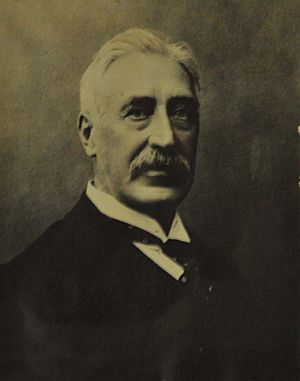John Eliot (meteorologist) facts for kids
Sir John Eliot (born May 25, 1839 – died March 18, 1908) was a very smart scientist. He was a mathematician and a meteorologist. A meteorologist is someone who studies weather. Sir John Eliot became the main weather expert for the Indian government. He worked to make weather predictions better, especially for the important monsoon rains. He led the Indian weather department from 1899 until he retired in 1903.
Contents
Life and Career
Early Life and Studies
John Eliot was born in Lamesley, England, in 1839. His father, Peter Elliott, was a school teacher. John later changed the spelling of his last name to Eliot. He started studying at St. John's College, Cambridge, in 1865. He was 26 years old, which was a bit older than most students. He was a brilliant student and graduated with high honors in 1869.
Moving to India
After college, John Eliot moved to India. He did this partly because of his health, as the English climate was not good for him. In India, he became a professor of mathematics. He taught at the Engineering College in Roorkee. In 1872, he moved to Allahabad. There, he continued to teach math and also managed the Meteorological Observatory.
Leading India's Weather Service
In 1874, Eliot moved to Calcutta. He became a professor of physical science at Presidency College. He also started reporting on the weather for the government of Bengal. In 1886, he took over from Henry Francis Blanford as the main weather reporter for the whole Indian government. In 1899, he became the director-general of all Indian observatories.
Improving Monsoon Predictions
Eliot's main goal was to improve predictions for the monsoon rains. These rains are very important for farming in India. His predecessor, Henry Blanford, had found a link between snowfall in the Himalayas and the strength of the monsoons. Eliot took this idea further. He looked for connections between monsoons and weather patterns in other parts of the world.
He believed that high pressure over places like Mauritius could affect the monsoons. Based on these ideas, he started making detailed monsoon forecasts. These reports could be almost 30 pages long!
Challenges and Successes
In 1899, Eliot predicted that India would have more rain than usual. However, India actually suffered a severe famine that year. This caused some embarrassment for the government. After this, his predictions were shared as private reports to the government.
Despite this challenge, Eliot greatly improved how weather work was done in India. He increased the number of weather stations from 135 to 240. Some of these stations were very high up in the mountains. He also got help from larger local states.
Under his leadership, weather information was shared more widely. He developed better ways to warn ships about storms at sea. He also sent telegraph messages about upcoming floods. This helped engineers protect important projects like railways and canals. These improvements saved the government a lot of money. He also made big steps in predicting droughts, which helped prevent famines.
Later Life and Honors
Eliot was recognized for his important work. He became a member of the Royal Society in 1895. This is a very respected group of scientists. He also received the honor of being made a Companion of the Indian Empire (CIE) in 1897.
He retired from India in 1903. He was then made a Knight Commander of the Indian Empire (KCIE). This means he was given the title "Sir." After returning to England, he continued his weather work. He joined a committee at the Solar Physics Observatory. He was also part of the International Meteorological Committee from 1896 until he died. This committee worked to collect weather data from all over the world.
Sir John Eliot was also a talented musician. He played both the organ and the piano very well. He married Mary Nevill in 1877. He passed away suddenly on March 18, 1908, in France. He was buried on his own property. He had three sons.
Key Contributions to Meteorology
Sir John Eliot's most important contributions to weather science are found in the many reports published by his department. He also wrote a valuable paper about Indian famines for a meeting of weather scientists in Chicago in 1893.
Here are some of his main publications:
- Report of the Vizingapatam and Backergunge Cyclones of October 1876 (1877): This report included maps of two major cyclones.
- Report on the Madras Cyclone of May 1877 (1879): Another important report with maps about a cyclone.
- Handbook of Cyclonic Storms in the Bay of Bengal (1890; 2nd edition 1900): This book was very helpful for sailors. It gave warnings and advice about storms.
- Climatological Atlas of India (1906): This amazing atlas had 120 plates (maps). It showed the results of his careful and organized work. He was preparing text to go with these maps, but he passed away before it could be published.


